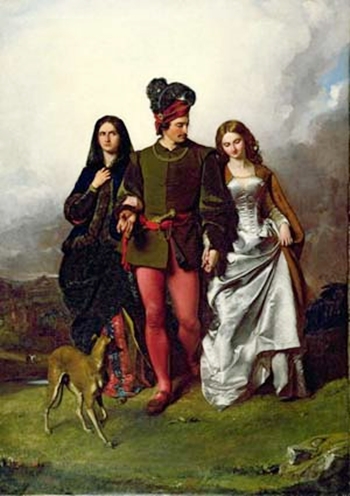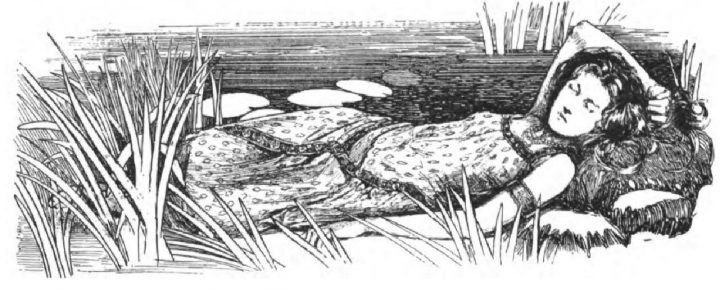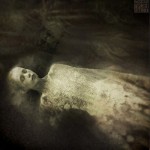Binnorie / The twa sisters is a traditional Scottish ballad from Norway, the topic of which is widespread in many countries around the world. (variation of the ballad The two sisters: jealousy and the supernatural)
It tells the story of a love triangle with two sisters who contend for the attention of a handsome young man, once his choice falls on the blonde one, the other (coincidentally with black hair) out of jealousy, kills her sister making her fall from the high of a cliff (or from the bank of a river).
Binnorie: “IL TRIANGOLO AMOROSO”

A dear theme to many pre-Raphaelite painters and more generally a recurring theme in 19th century painters (thanks to Sir Walter Scott’s good offices); in the painting of the Scot John Faed (1851) entitled “Cruel Sister” it is summarized the whole drama of jealousy at the center of history (read motive); a prince with an exotic charm (what a feathered hat!) holds a blond girl dressed in white satin by the hand, not only does the prince look at her and tenderly shakes her hand, but also points to a little dog in the foreground, to say, “here I am faithful”. What a grace and sweetness is suffused in the girl who, with modesty, turns her gaze to the ground, but her cheeks are colorated, a sign of a profound emotion that disturbs her. The other girl is slightly backward compared to the two lovers and , afflicted by dark thoughts, she looks at the prince; even if she grasps to his arm she is clearly the third wheel. (note that while the two lovers move with the same step the black lady moves in forward the left foot).
To understand the whole story, here is a Scottish fairy tale called “The Singing Breastbone” (from Fair is Fair: World Folktales of Justice of Sharon Creeden see) that already in the title announces a “gothic” story.
The Singing Breastbone (Binnorie)

She has taken her by the lily white hand
binnorie o binnorie
ONCE upon a time there were two king’s daughters who lived in a bower near the bonny mill-dams of Binnorie. And Sir William came wooing the elder and won her love, and plighted troth with glove and with ring. But after a time he looked upon the younger sister, with her cherry cheeks and golden hair, and his love went out to her till he cared no longer for the elder one. So she hated her sister for taking away Sir William’s love, and day by day her hate grew and grew and she plotted add she planned how to get rid of her.
So one fine morning, fair and clear, she said to her sister, ‘Let us go and see our father’s boats come in at the bonny mill-stream of Binnorie.’ So they went there hand in hand. And when they came to the river’s bank, the younger one got upon a stone to watch for the beaching of the boats. And her sister, coming behind her, caught her round the waist and dashed her into the rushing mill-stream of Binnorie.
‘O sister, sister, reach me your hand !’ she cried, as she floated away, ‘and you shall have half of all I’ve got or shall get.’
‘No, sister, I’ll reach you no hand of mine, for I am the heir to all your land. Shame on me if I touch her hand that has come ‘twixt me and my own heart’s love.’
‘O sister, O sister, then reach me your glove !’ she cried, as she floated further away, ‘and you shall have your William again.’
‘Sink on,’ cried the cruel princess, ‘no hand or glove of mine you’ll touch. Sweet William will be all mine when you are sunk beneath the bonny mill-stream of Binnorie.’ And she turned and went home to the king’s castle.
And the princess floated down the mill-stream, sometimes swimming and sometimes sinking, till she came near the mill. Now, the miller’s daughter was cooking that day, and needed water for her cooking. And as she went to draw it from the stream, she saw something floating towards the mill-dam, and she called out, ‘Father ! father ! draw your dam. There’s something white–a merrymaid or a milk-white swan–coming down the stream.’ So the miller hastened to the dam and stopped the heavy, cruel mill-wheels. And then they took out the princess and laid her on the bank.
Fair and beautiful she looked as she lay there. In her golden hair were pearls and precious stones; you could not see her waist for her golden girdle, and the golden fringe of her white dress came down over her lily feet. But she was drowned, drowned !
And as she lay there in her beauty a famous harper passed by the mill-dam of Binnorie, and saw her sweet pale face. And though he travelled on far away, he never forgot that face, and after many days he came back to the bonny mill-stream of Binnorie. But then all he could find of her where they had put her to rest were her bones and her golden hair. So he made a harp out of her breast-bone and her hair, and travelled on up the hill from the mill-dam of Binnorie till he came to the castle of the king her father.
That night they were all gathered in the castle hall to hear the great harper–king and queen, their daughter and son, Sir William, and all their Court. And first the harper sang to his old harp, making them joy and be glad, or sorrow and weep, just as he liked. But while he sang, he put the harp he had made that day on a stone in the hall. And presently it began to sing by itself, low and clear, and the harper stopped and all were hushed.
And this is what the harp sung:
‘O yonder sits my father, the king,
Binnorie, O Binnorie;
And yonder sits my mother, the queen;
By the bonny mill-dams o’ Binnorie.
‘And yonder stands my brother Hugh,
Binnorie, O Binnone;
And by him my William, false and true;
By the bonny mill-dams o’ Binnorie.’
Then they all wondered, and the harper told them how he had seen the princess lying drowned on the bank near the bonny mill-dams o’ Binnorie, and how he had afterwards made his harp out of her hair and breast-bone. Just then the harp began singing again, and this is what it sang out loud and clear:
‘And there sits my sister who drowned me
By the bonny mill-dams o’ Binnorie.’
And the harp snapped and broke, and never sang more.
As usual, the fairy tale lends itself to multiple readings outside the text, symbolism focuses on the meaning of the bones, the swan and the water element (see) and yet in the American version the ballad becomes a more typical murder ballad
BINNORIE
In Scotland the ballad was printed in 1656 under the title “The Miller and the King’s Daughter” [see first part: The Miller And The King’s Daughter/The Twa Sister] and then ended in the Child Ballads, (# 10), in his “The English and Scottish Popular Ballads”: the versions in Child are about twenty to underline the wide popularity and diffusion of the story (and also for the melodies there are many versions).
The version analyzed, however is that of Sir Walter Scott (in “Minstrelsy of the Scottish Border” 1802 see ) who with his books helped to reawaken the interest of contemporaries towards Medievalism.
The text is rich in Scottish terms, the plot is very similar to the fairy tale “The Singing Breastbone” of which the ballad seems to be the sung version, the tragic epilogue is tinged with magic with the bones of the girl become musical instrument to unmask the killer.
There were twa sisters sat in a bow’r(1)
Binnorie, O Binnorie (2)
There cam a knight to be their wooer.
By the bonnie mill-dams of Binnorie .
He courted the eldest wi’ glove and ring (3)
But he lo’ed the youngest aboon a’thing.
The eldest she was vexed sair
And sore envied her sister fair.
The eldest said to the youngest ane:
“Will you go and see our father’s ships come in”
She’s ta’en her by the lily hand
And led her down to the river strand.
The youngest stude upon a stane
The eldest cam’ and pushed her in.
“Oh sister, sister reach your hand
And ye shall be heir of half my land”
“Oh sister, I’ll not reach my hand
And I’ll be heir of all your land.”
“Oh sister, reach me but your glove
And sweet William shall be your love.”
“Sink on, nor hope for hand or glove
And sweet William shall better be my love.”
Sometimes she sunk, sometimes she swam
Until she cam to the miller’s dam.
The miller’s daughter was baking bread
And gaed for water as she had need.
“O father, father, draw your dam!
There’s either a mermaid
or a milk-white swan (4).”
The miller hasted and drew his dam
And there he found a drown’d woman.
Ye couldna see her yellow hair
For gowd and pearls that were sae rare.
Ye coldna see her middle sma’
Her gowden girdle was sae braw.
Ye couldna see her lily feet
Her gowden fringes were sae deep.
A famous harper passing by
The sweet pale face he chanced to spy.
And when he looked that lady on
He sighed, and made a heavy moan.
He made a harp (5) o’ her breast bone
Whose sounds would melt a heart of stone.
The strings he framed of her yellow hair,
Their notes made sad the listening ear (6).
He brought it to her father’s ha’
There was the court assembled there.
He layed the harp upon a stane (7)
And straight it began to play alane.
“O yonder sits my father the King
And yonder sits my mother, the queen.”
“And yonder stands my brother Hugh
And by him, my William, sweet and true.”
But the last tune that the harp played then
Was: “Woe to my sister, false Helen”
FOOTNOTES
1) in the Middle Ages, bower indicated the private room of the lady of the castle, not exactly the bedroom when the room in which she stayed with her maidservants.
2) Scott replaces the refrain “Edinburgh, Edinburgh” inspired by the battle of Binnorie (to commemorate the Scottish wars of independence)
3) Giving the ring and the glove in medieval times was a promise of marriage. To be courted was the older sister, it was a matter of a arranged marriage. in which however the young falls in love with the younger sister
4) The comparison emphasizes the purity and innocence of the girl who is presumed not to have encouraged the advances of the suitor.
5) a magical harp, in fact, as soon as it is placed on a stone, it begins to sing alone. Here we refer to the Viking belief that the soul resides in the bones (the bones of the dead accuse their murderers). The killer sister who was about to marry, is unmasked by her sister’s ghost and will surely be punished as she deserves.
It is reasonable to assume that in the Scandinavian versions the instrument was in reality an arched crwth or lyra: also called “Germanic crwth” – to underline its northern origin – the instrument can also be equipped with a central keyboard and you play with the bow being probably the ancestor of the violin. In Wales it is called crwth (while in Ireland it is called cruith) and the central keyboard bears six strings, two of which the drone strings (“loafer string”). This instrument, which scholars are uncertain if they consider it to be completely indigenous and attributed to the Scandinavian area, (see)
6) referring to the ability of the harp to soften a heart of stone (black heart) so its magic song begins only when they placed it on a stone
Giordano Dall’Armellina writes in his essay: “Summing up the English and the Scandinavian versions a hundred texts have been calculated: it is as if every singer had fun inventing something different to distinguish himself from the others. In some Norwegian variants the harp crash into many pieces and the blond princess returns to life while her black-haired sister is either burned alive or buried alive as a punishment for the crime committed.
In another, always Norwegian, the bones of the girl are used to make a flute that is brought to her family to make it play by everyone. When the cruel sister plays it, the blood gushes from it, thus denouncing her guilt. It follows a punishment: the sister is condemned to be tied to four horses that leave in four distinct directions and that will cut her to pieces. In a Swedish version the miller saves the girl and brings her back to her family. In the end the blond princess will forgive her sister for the attempted murder” (translated from Giordano Dell’Armellina: “Ballate Europee da Boccaccio a Bob Dylan”.)
LINK
“Racconti comuni in ballate italiane, svedesi e britanniche: un confronto” see
Giordano Dall’Armellina: “Ballate Europee da Boccaccio a Bob Dylan”: http://www.dallarmellinagiordano.it/libri/ballate-europee-da-boccaccio-a-bob-dylan/
http://members.chello.nl/r.vandijk2/ChildBallads010-019.html
http://www.antiwarsongs.org/canzone.php?id=49269&lang=it
http://walterscott.eu/education/ballads/supernatural-ballads/the-cruel-sister/



